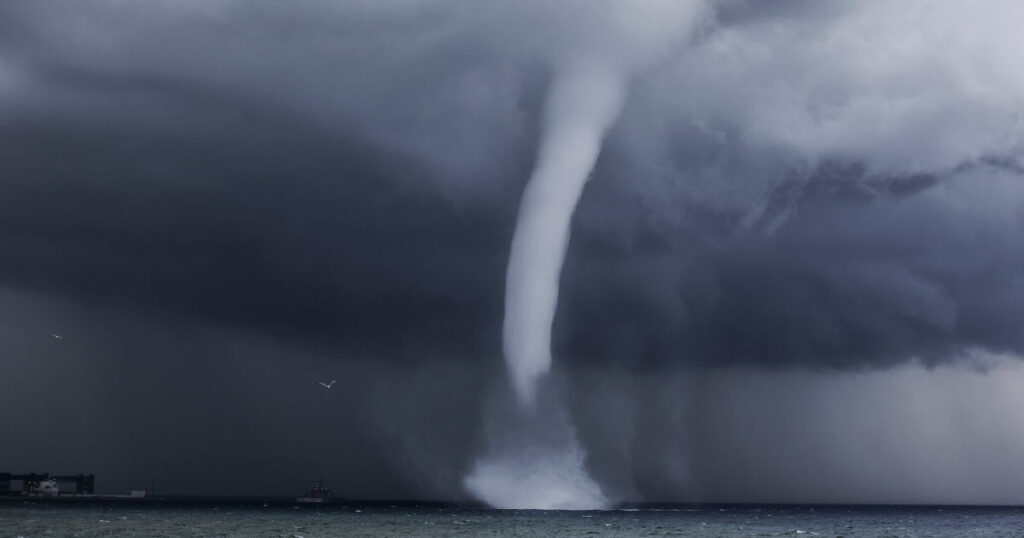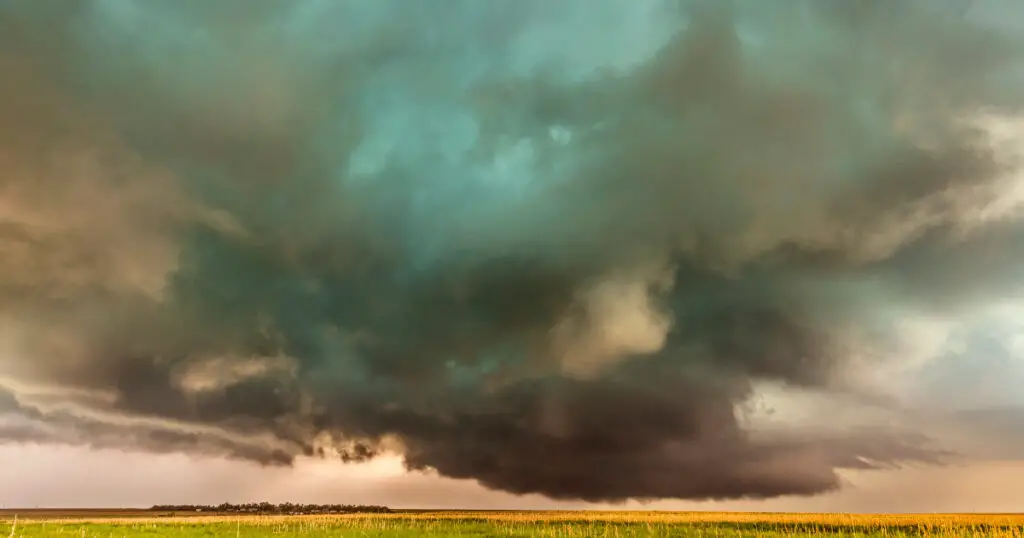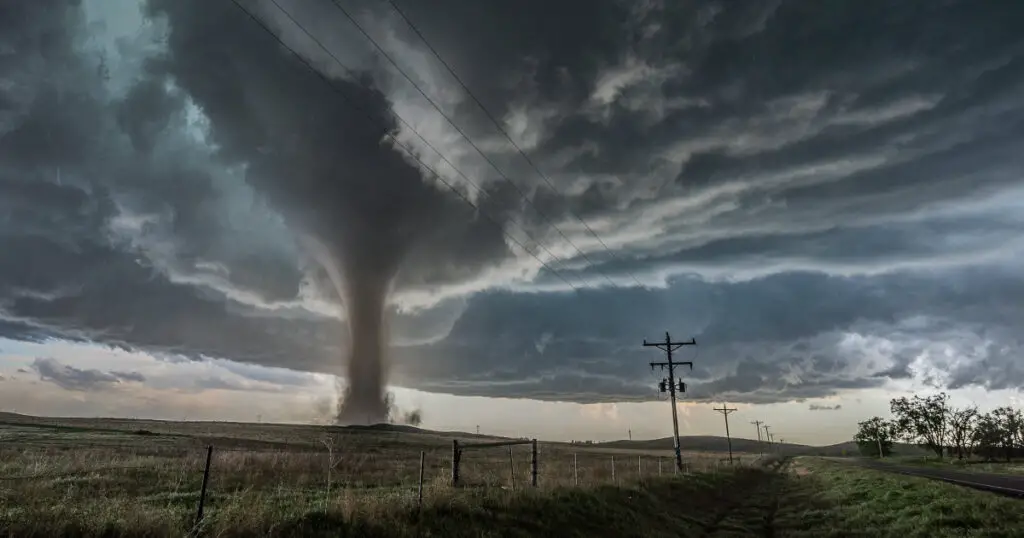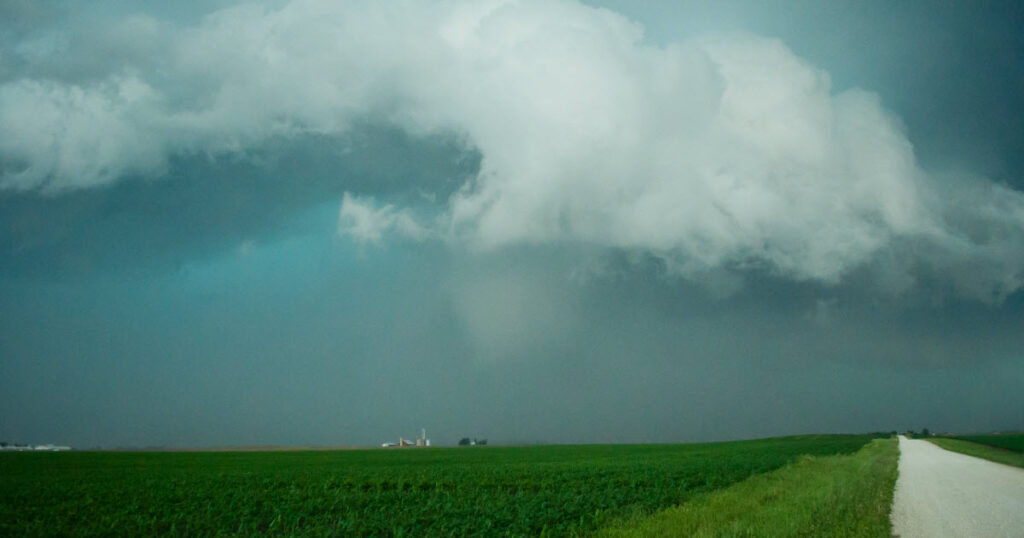A waterspout tornado is a twister that forms over an ocean, lake, or river. Compared to tornadoes, hurricanes, fire storms, and thunderstorms, waterspout tornadoes may sound less threatening. However, while waterspouts are weaker and don’t last as long as most of their fellow weather phenomena, some waterspouts can be just as destructive.
In today’s article we’ll explore the different types of waterspout tornadoes, how, where, and when they form, the dangers and risks associated with this weather event, and finally we’ll share some interesting facts and trivia about Waterspout tornadoes around the world.
Let’s get started!
All About the Waterspout Tornado
A waterspout tornado, also called a sea tornado, is a rapidly rotating, cloud-filled column of air and mist that descends from a cumulus cloud. While it shares some of the characteristics of a land tornado, what makes it unique is that instead of traveling on land, a waterspout tornado moves across the water surface. Despite its name, a waterspout does not “spout” from the water. Instead, the water inside it comes from condensation in the cloud.
Waterspout tornadoes are less devastating than land tornadoes. But this has less to do with their power or wind speed, and more to do with the fact that waterways are less densely populated, and because there is less debris available to be drawn into the circulation.
There are two major types of waterspouts:
- Tornadic waterspouts, and
- Fair-weather waterspouts.
We’ll discuss each of these below:
Tornadic Waterspouts
Tornadic waterspouts form over water or move from water to land. Like land tornadoes, they are associated with severe thunderstorms extending from cumulonimbus clouds. Most tornadic waterspouts occur in the afternoon, just like traditional tornadoes which form over land.
Tornadic waterspouts are often also accompanied by large hail, high winds, and frequent lightning.
They tend to be stronger and more destructive, but are less common than fair-weather waterspouts.
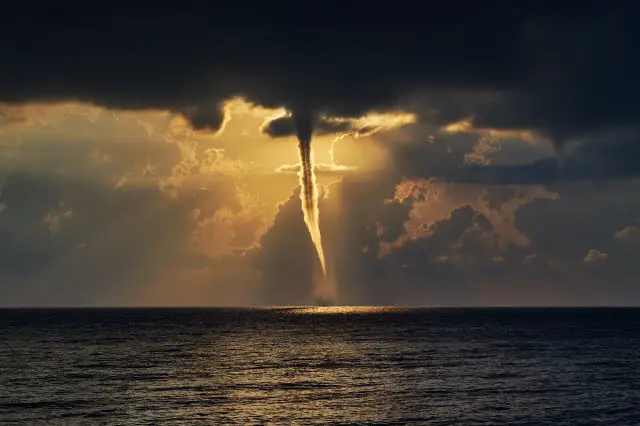
Fair-weather Waterspouts
Fair-weather waterspouts, on the other hand, usually form during periods of mild, warm, and sunny weather. They can occur without a “parent” thunderstorm, and they often spawn from developing storm systems instead of active storms.
Unlike tornadic waterspouts that move downwards, fair-weather waterspouts usually rise along the dark flat base of a line of cumulus clouds, then continue to work their way upwards.
The clouds from which they form from are not fast-moving ones, which means that many of them are static or move very little, and they are rarely dangerous.
When fair-weather waterspouts make landfall, they rapidly dissipate and seldom move inland.
Fair-weather waterspouts typically occur in the morning, or sometimes in the early afternoon.
Snowspout
A rare type of waterspout we should also mention is the snowspout. Also called an ice devil or snownado, a snowspout occurs during the winter season at the base of a snow squall.
It is so uncommon that only a few photos of them exist.
How Does a Waterspout Tornado Form?
High levels of humidity and a warmer water temperature compared to the overlying air are two of the factors that enable the formation of both tornadic and fair-weather waterspouts.
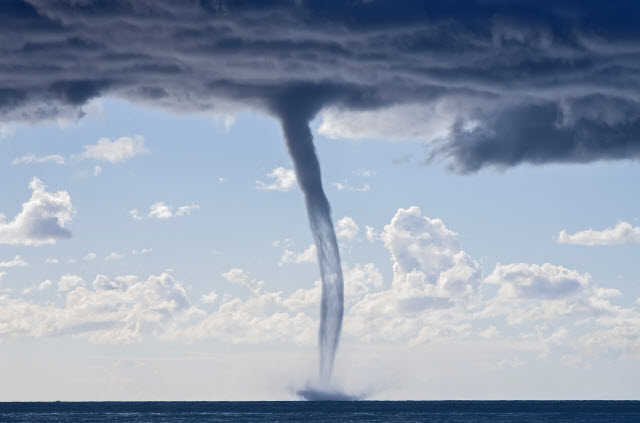
Waterspout formation typically involve five stages:
The 5 Stages of Waterspout Tornado Formation
- Dark Spot – In this stage, the surface of the water looks darker. This spot is where the vortex or column of rotating air reaches the water. Then, a prominent, light-colored disk forms near the surface of the water. A larger dark area of indeterminate shape with diffused edges usually surrounds the disk or circular figure.
- Spiral Pattern – Light and dark-colored bands creating a spiral pattern emanate from the dark spot.
- Spray Ring – Swirling rings of sea spray called cascades form around the center of the dark spot. At the center of the dark spot an eye also appears, similar to the kind seen in a hurricane.
- Mature Vortex – The waterspout is now at its most intense phase. It becomes visible from the surface of the water to the cloud mass overhead. It also appears to have a hollow funnel, and a turbulent shell of condensation surrounds it. The spray vortex that accompanies it can rise several hundred feet, creating a visible wake and wave train as it moves.
- Decay – When the flow of warm air into the vortex weakens, the waterspout begins to collapse and dissipate.
| Related Posts |
|---|
Where and When Does a Waterspout Tornado Form?
Waterspout tornadoes can form almost anywhere, but they are more common in tropical and subtropical regions, and in areas where there are frequent thunderstorms over large bodies of water.
They can form in salt water, fresh water, in small lakes, or wide open seas.
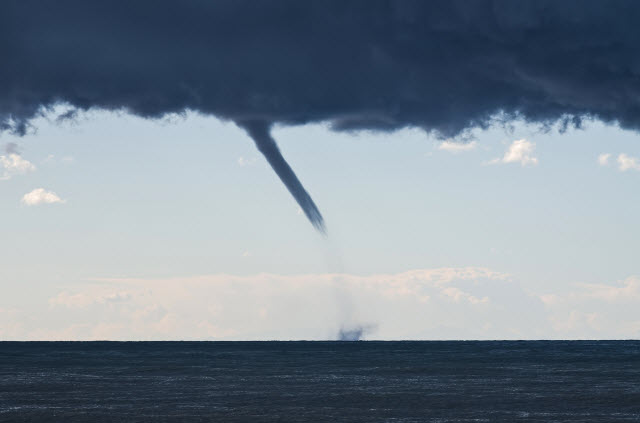
In the United States, waterspout tornadoes typically appear along the Florida Keys and in the Gulf of Mexico. Some also occur over the Great Lakes and Chesapeake Bay.
Outside the US, waterspouts are a common occurrence in the islands of Greece and the east coast of Australia. They can also form along the western coast of Europe, the Mediterranean Sea, and the Baltic Sea.
The peak activity of waterspout tornadoes is in the late spring and the summer months, with most generally forming in the mid-afternoon or later.
How Dangerous is a Waterspout Tornado?
Waterspout tornadoes are not as dangerous as their land-based counterparts, but they are considered a marine hazard.
The size of a waterspout’s funnel is about 50 meters, but some of the largest waterspouts can measure over 100 meters in diameter.
The average lifespan of a smaller waterspout tornado is about 5 to 10 minutes. However, waterspouts with a diameter of over a hundred meters can last up to an hour.
The average wind speed of waterspout tornadoes is approximately 50 mph. However, tornadic waterspouts can travel at wind speeds of over 100 mph. The waves they generate are strong enough to capsize large vessels, destroy marine life, and damage coral reef systems.
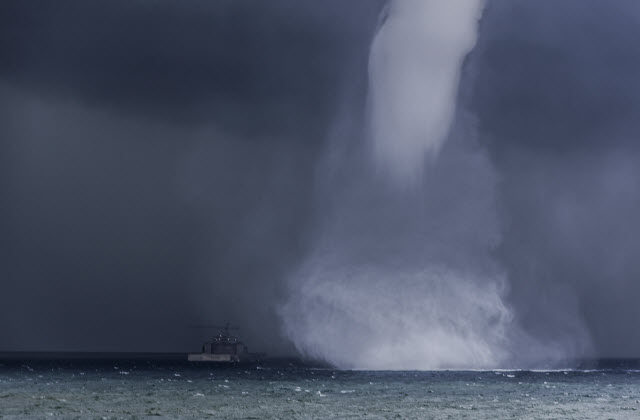
Waterspouts can also suck up ocean water along with fish and other creatures or debris floating in the water. When the wind speed decreases, they can fall back into the water or on the ground, miles away from where they started.
In some instances, waterspouts sweep debris and water creatures high into the clouds, encasing them in a layer of ice or hail. When the debris and creatures wrapped in blocks of ice fall from the atmosphere and plummet to the ground, they can smash through roofs, car windshields, or damage any surface they come into contact with.
Waterspouts can also be a threat to aircraft passing over them. They can damage, blow away, or draw airplanes into their funnel.
What To Do When You See a Waterspout Tornado?
While waterspout tornadoes are a wondrous sight to behold, care should be taken when you’re about to face one of these natural weather conditions.
Before a waterspout
- Listen to the radio or watch TV broadcasts for the latest marine weather news.
- Be familiar with warning signs, like a dark spot on the water’s surface followed by rings or a sudden shift in wind speed and direction.
- Keep an auto-activated distress beacon in case of emergency.
During a waterspout
- Don’t move towards or through a waterspout.
- Move your vessel at a 90-degree angle away from where the swirling motion is happening.
- Wait it out from a distance.
- If the waterspout is headed directly towards your vessel, take down sails, close hatches, and if possible seek shelter below deck.
- Going overboard can be an option to avoid flying debris, but it may pose risks like hypothermia and drowning. Be sure to wear your life preserver or PFD when out on the water.
After a waterspout
- Place a mayday call to assist search and rescue teams as they work to locate you.
- If your boat capsizes, climb onto the hull and stay with it until rescue arrives.
Interesting Facts about Waterspout Tornadoes
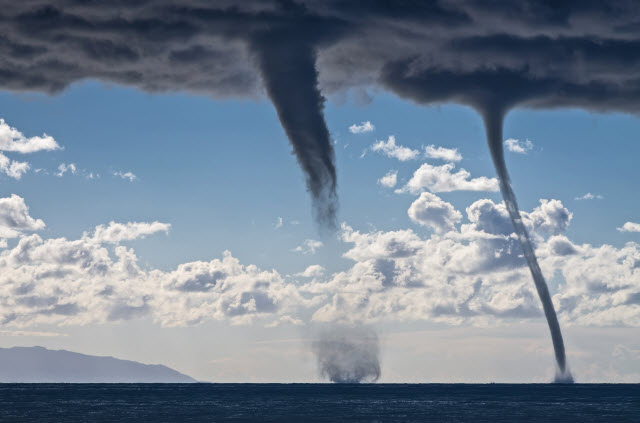
Below are a few surprising facts about waterspouts:
Florida is the waterspout capital of the US
An estimated 500 waterspouts form off the coast of Florida annually.
This happens because the waters surrounding the state provide the right amount of warmth and moisture to grow clouds that spawn waterspout tornadoes.
The earliest waterspout in history was spotted in Italy in 1456
The science of waterspouts have only been unraveled recently, but it is known that they have been occurring since ancient times.
The earliest record of a waterspout is in 1456 on the sea near Ancona, Italy. It was about two miles wide.
Other early waterspout incidents of note are:
- Malta, 1556. A tornadic waterspout wrecked houses inland as well as the war fleet of the Knights of St. John, sinking vessels and drowning knights, soldiers, and slaves.
- London, 1626. During a violent thunderstorm, a waterspout formed in the River Thames near the House of Parliament.
- Tyrrhenian Sea, 1749. From the sea, a waterspout made landfall, traveling 43 kilometers from Ostia to Rome.
Waterspouts can cause animal rain
Here are places where animal rain incidents (times when creatures have rained from the sky) have been reported:
- Fish: Singapore (1861), Louisiana (1947), Sri Lanka (2014), Ethiopia (2016)
- Jellyfish: England (1894)
- Spiders: Australia (1974 and 2015), Brazil (2013)
- Frogs: Japan (2009), Hungary (2010), Uruguay (2011)
- Worms: Louisiana (2007)
The highest number of waterspout recorded is 232
The outbreak happened in the Great Lakes in a period of seven days, from September 28 to October 4, 2020.
This cluster of waterspout tornadoes broke the old record of 88 waterspouts that occurred from August 16 to 19, 2020.
2020 was quite a year.
